Career Probationary Fire Fighter Dies While Participating in a Live-Fire Training Evolution at an Acquired Structure - Maryland
 Death in the Line of Duty…A summary of a NIOSH fire fighter fatality investigation
Death in the Line of Duty…A summary of a NIOSH fire fighter fatality investigation
F2007-09 Date Released: December 8, 2008
SUMMARY
On February 9, 2007, a 29-year-old female, career probationary fire fighter died while participating in a live-fire training evolution at an acquired structure. The victim’s class was conducting a live-fire training drill that is required by the department’s training protocol for their NFPA 1001, Standard for Fire Fighter Professional Qualifications, Fire Fighter I. The victim was part of a four person engine company, led by an adjunct instructor, that made the initial attack on a training fire in a vacant, condemned, three-story, end-unit, townhouse. The scenario called for the victim’s crew to enter the front of the townhouse and proceed to the third floor to find and extinguish any fire on the third floor. They were to by-pass any fire on the second floor so that the second due engine could practice suppression on that floor. The victim’s crew encountered heavy fire on the second floor and third floor stairwell as they proceeded to the third floor. The victim, operating the nozzle, and the adjunct instructor attempted to fight fire on the third floor, but conditions made it untenable. The adjunct instructor was able to exit through a window located on the third floor landing followed by a fire fighter who was backing up the victim on the hoseline. However, the victim got stuck attempting to exit the window which was 41-inches above the floor. The victim became unresponsive as the adjunct instructor and other fire fighters attempted to free her from the window. After she had been freed, she was transported to a local trauma center where she was pronounced dead. NIOSH investigators concluded that, to minimize the risk of similar occurrences, fire departments should:
- conduct live-fire training exercises in accordance with the most recent edition of NFPA 1403, Standard on Live-Fire Training Evolutions
- ensure all training and education, including live fire training, is conducted under the direct supervision of a qualified instructor(s) who meets the requirements of NFPA 1041, Standard for Fire Service Instructor Professional Qualifications
- provide the Training Academy and Safety Division with adequate resources, personnel, and equipment to accomplish their training mission safely
- screen recruits to ensure they meet the physical performance requirements as established by the fire department prior to entering a training program to become a fire fighter
- develop and maintain a comprehensive respiratory protection program which complies with NFPA 1404, Standard for Fire Service Respiratory Protection Training
- ensure all recruits meet the requirements of NFPA 1582, Standard on Comprehensive Occupational Medical Program for Fire Departments prior to entering the training program
- develop an inspection criteria to ensure that all protective ensembles meet the requirements of NFPA 1851, Standard on Selection, Care, and Maintenance of Structural Fire Fighting Protective Ensembles
- ensure coordinated communication between the Instructor-in-charge and the live-fire training participants
- utilize the incident command system and a personnel accountability system, for all incidents, including live fire training exercises, that meets the requirements of NFPA 1561, Standard on Emergency Services Incident Management System
- create a training atmosphere that is free from intimidation and conducive to learning
Additionally;
- States should develop a permitting procedure for live-fire training to be conducted at acquired structures and also ensure that all the requirements of NFPA 1403 have been met before issuing the permit
INTRODUCTION
On February 9, 2007, a 29-year-old, female career, probationary fire fighter (the victim) was fatally injured. On February 9, 2007, the U.S. Fire Administration notified the National Institute for Occupational Safety and Health (NIOSH) of this incident. On March 19-23, 2007, two Safety and Occupational Health Specialists and a Safety Engineer from the NIOSH Fire Fighter Fatality Investigation and Prevention Program investigated this incident. Meetings were conducted with the fire department; city safety office; representatives of the National Institute of Standards and Technology (NIST); the Bureau of Alcohol, Tobacco and Firearms (ATF); the State’s Occupational Safety and Health Administration (MOSHA); and, the International Association of Fire Fighters (IAFF). Interviews were conducted with fire fighters and officers who were involved with this incident, the training academy officials, and the fire department safety office. The investigators reviewed the victim’s training records, the department’s standard operating procedures (SOPs), autopsy reports, witness statements, the victim’s personal protective equipment, the manufacturer’s turnout gear inspection report, the training academy’s curriculum and instructor’s qualifications. The incident site was visited and photographed. The investigators also viewed a video of a previous live-fire training event.
Fire Department
This career department consists of 1,700 uniformed fire fighters in 40 fire stations that serve a population of about 636,000 in a geographic area of approximately 81 square miles. The fire department did not provide any documentation on a comprehensive evaluation process for promoting officers to ranks of increased responsibility. Every officer and fire fighter interviewed stated that the fire department did not have a set policy regarding promotion.
Prior to October 2006, the fire department’s organizational structure had the safety battalion reporting through the maintenance section under the administrative division. After October 2006 and up to the fatal training incident, the safety battalion reported to the fire marshal section under the administrative division. At the time of this incident, the safety battalion consisted of 1 chief safety officer, 1 safety officer/shift, and 1 or 2 more safety officers on day shift. There was not a requirement for an officer from the safety battalion to oversee any live-fire training events.
Recruits who graduated from the training academy were trained to the requirements of the National Fire Protection Association (NFPA) 1001, Standard for Fire Fighter Professional Qualifications, Fire Fighter Level I and II. Because of a shortage of State-certified instructors and the lack of resources to pay the existing State-certified instructors overtime, the department had advertised for full-time fire fighters to act as adjunct instructors and assist with recruit training. In return, these instructors would be compensated with time off for the time they assisted with training.
The burn building at the training academy was condemned at the time of the NIOSH investigation. There was also a mobile live-fire trailer at the academy that was not used. The size and safety features of the mobile live-fire trailer limited the number of recruits that could be trained in a single evolution. This did not meet the needs of the fire department. As part of the investigation, NIOSH reviewed a video that showed NFPA 1403, Standard for Live Fire Training Evolutions was not followed during previous live-fire training evolutions.
Physical Entry Standards for Fire Fighter Recruit Candidates
The fire department does not have any physical fitness requirements. The fire department does not have selection criteria, such as the Candidate Physical Ability Test Program (CPAT) that was developed by the IAFF and the International Association of Fire Chiefs (IAFC) joint labor-management wellness/fitness initiative, to ensure that recruits are physically able to safely and effectively complete the critical tasks associated with fire fighting. During the investigation, all of the fire department officers interviewed stated that the city had removed physical fitness requirements after a change of administration several years prior to the incident, in an attempt to recruit a more diversified work force. The fire department subsequently developed a physical ability test to evaluate prospective recruits on the time to complete specific fire fighting tasks, but the test was not developed using national consensus standards. Although the fire department developed a test, a recruit could still continue to become a fire fighter even though they did not meet the time requirements for the test. It was reported to NIOSH investigators that the fire department relied on self-elimination of recruits as the only means of screening candidates. Information provided during multiple interviews suggests that the environment at the training academy was to pressure the less qualified recruits to drop-out.
Training and Experience
The victim was a probationary fire fighter who had not yet completed the last requirement for NFPA 1001, Standard for Fire Fighter Professional Qualifications, Level I certification which was live-fire training. She reportedly had experienced mask claustrophobia while wearing a facepiece in previous training evolutions. It was also reported that the victim did not meet the minimum required time to complete the physical ability test developed by the fire department when she was hired. She reportedly was re-tested just prior to the incident, and produced a slower time than the initial test. Documentation was not provided to the investigative team regarding her physical ability testing.
The officer-in-charge (OIC) was a Lieutenant who had received training through the State Fire and Rescue Institute on topics such as Instructor I and II and Fire Skills for Instructors. He had over 25 years of fire fighting experience.
The Safety Officer was a District Chief who was in charge of the training academy. He had received training through the State Fire and Rescue Institute on topics such as Leadership and Supervision, Fire Command, and Methods of Instructor Level II – Teaching and Program Development Techniques. He had over 20 years of fire fighting experience.
None of the adjunct instructors that participated in this training evolution had any training as a fire instructor. The Adjunct Instructor for the victim’s squad had over 9 years of fire fighting experience. This was the first time he had acted as a training instructor.
Personal Protective Gear
The protective ensemble (personal protective gear) that was used at the training academy was equipment that had been removed from service as newer equipment became available to the full-time fire fighters in the field. Self contained breathing apparatus, flashlights, radios and other safety equipment were provided on an as needed basis. Through interviews it was noted that some of the participants did not have PASS devices, and that there were not enough radios for all of the instructors associated with the training.
The turnout gear that was worn by the victim was sent by the department to the manufacturer for inspection. The NIOSH investigative team noted that there were little to no signs of heat exposure on either the coat or the pants (Photos 1 and 2).
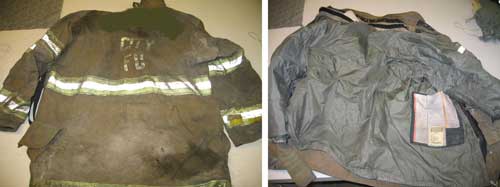 |
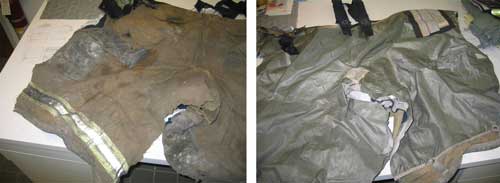 |
Photo 2. Turnout pant shell and liner worn by victim. |
The coat was manufactured in 2002 and was reported by the manufacturer to still be in serviceable condition, but requiring extensive cleaning. The pants were manufactured in 1997. The manufacturer reported that the pants shell and liner were beyond their useful life and that they should have been retired. The manufacturer reported that thermal protection and moisture integrity was diminished due to abrasion and wear, especially in the crotch area of the pants (Photo 3).
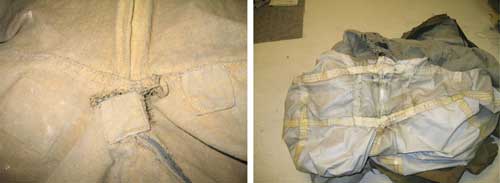 |
|
Photo 3. The repaired crotch area of the turnout pants shell, and inverted liner with diminished thermal integrity due to age and use.
|
Structure
The department was using an acquired structure for their live-fire training, which was a three-story, end unit townhouse of ordinary construction that came to a 45-degree angle at the A/D corner (Figure 1). It had three bedrooms and approximately 1,200 square feet of living area. The building was designated a vacant structure by the city in June of 1999, and was then condemned in January of 2004.
Several weeks prior to the day of the incident, the structure had been used to practice forcible entry and ventilation operations. Portions of the walls and ceilings had been removed from the structure during those exercises.
The first and second floors were approximately 44 feet long by 11 feet wide. The first floor consisted of a kitchen and a central stair case separating a front and a rear room. On the second floor, a bathroom and the staircase separated a rear and front bedroom. The third floor was above only the front portion of the townhouse. It had a front bedroom and a hallway that led to the stairway. The landing at the top of the stairs to the third floor contained a window on the C-side wall (Figure 1). The window sill was approximately 3-foot 5-inches above the floor and approximately 2-foot 3-inches wide (Photo 4).
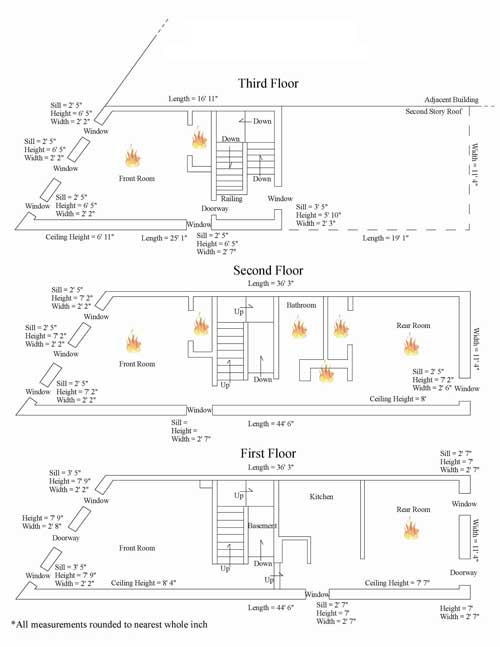 |
|
Figure 1. Layout of the fire structure. Fire symbols designate the location of the individual training fires set for the training evolution |
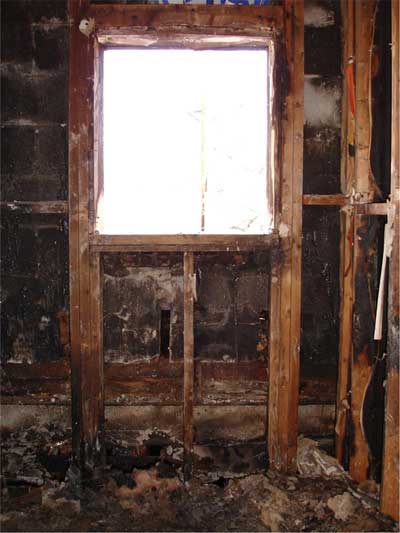 |
|
Photo 4. Window sill on third floor landing looking towards the rear or C-side of the structure. Sill is 41-inches above floor level.
|
Fire Locations and Fuel Loads
Through interviews it was determined that at least 12 wooden pallets, 11 bales of excelsior, and miscellaneous trash from the structure were used to light the fires in either a teepee or a lean-to configuration. The teepee arrangement consisted of a pallet flat on the floor with two others on top leaning into the center supporting one another. A bale of excelsior was placed in the void area. The lean-to consisted of a pallet leaning against a wall with a bale of excelsior underneath (Figure 2).
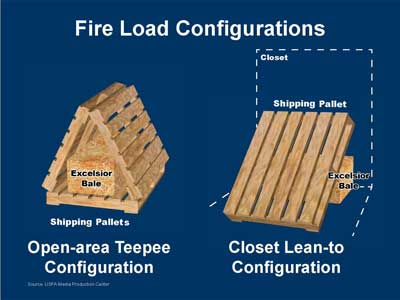 |
|
Figure 2. Example of fire load configurations
(Courtesy of USFA Media Production Center). |
During the site walkthrough and corroborated by interviews, it appeared that nine fires were set in the acquired structure. There was one in the rear room on the first floor which consisted of an automotive tire, several mattresses, foam rubber chair, a tree branch, and other debris that may be found in an abandoned residential structure. Teepee configuration fires were set in the second floor front and rear bedrooms, and the third floor front bedroom. Lean-to fires were set in the closets of the three bedrooms (see Appendix 1 for fire load details). There were also fires set in both the bathroom and hall closet on the second floor using approximately one bale of excelsior. None of the instructors or fire fighters that were interviewed reported knowledge of the fire that was set on the first floor.
Through the interviews and during the walkthrough it was noted that excelsior was also stuffed into wall and ceiling openings, duct work vents, and behind drywall where it existed and/or was accessible (Photo 5).
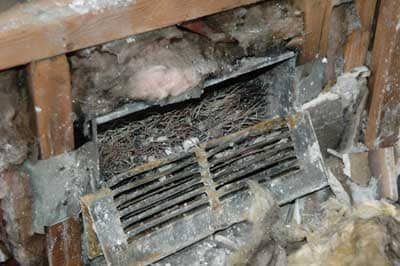 |
|
Photo 5. Excelsior that was stuffed into duct work vents.
|
Weather Conditions
The conditions were clear with the temperature averaging 26-degrees Fahrenheit. The wind was between 13 and 25 miles per hour with gusts up to 35 miles per hour from the North to Northwest.
Personnel
- Engine 1
- Adjunct Instructor, victim, 3 students
- Engine 2
- Adjunct Instructor, 4 students
- Engine 3 Rapid Intervention Crew (RIC)
- Academy Instructor, 3 students
- Truck 1
- Adjunct Instructor, 4 students
- Truck 2
- Adjunct Instructor, 3 students
- Truck 3
- Adjunct Instructor, 4 students
- Medic 21
- 2 Paramedics
- Instructor-in-charge
- Lieutenant, Academy Instructor
- Safety Officer
- Division Chief, Academy Director
- Ignition Officer
- Academy Instructor
- Ignition Officer
- Adjunct Instructor
- Pump Operator
- Academy Instructor
- On the scene, but did not participate in training exercise
- Battalion Chief
Truck 10- Officer, 3 fire fighters
- Engine 14
- Officer, 3 fire fighters
INVESTIGATION
On February 9, 2007, at approximately 1000 hours, the fire department prepared to conduct a live-fire training evolution at an acquired structure. The training was required by the department as part of the requirements for NFPA 1001, Standard for Fire Fighter Professional Qualifications, Fire Fighter I certification. The scenario was to provide the recruits with a realistic first alarm response to a working structure fire that they might encounter within the city that would include three engines and three truck companies. The victim’s crew, which was the first due engine, was to make entry into the front of the structure, by-pass any fire on the second floor, and proceed to the third floor to find and extinguish fire. The second due engine was to make entry through the rear of the structure and proceed to the second floor to fight fire. Note: None of the training participants, including instructors, reported having knowledge that a fire was to be set on the first floor. There was no walk-through and no explanation of the structure’s layout provided to the recruits prior to the training evolution. Engine 3 was to assemble their gear at the front of the structure and act as the Rapid Intervention Crew/Company (RIC). Note: The RIC instructor was on light-duty and was not physically able to participate. Truck 1 was to place ground ladders against the front of the structure and then enter to conduct search and rescue. Truck 2 was to operate from the rear of the building to provide forcible entry and ventilation. Truck 3 was assigned to access the adjacent roof via the aerial ladder and provide vertical ventilation to the acquired structure.
At approximately 1135 hours, the fires on all three levels were ignited to begin the training exercise. Approximately four minutes later, a simulated box alarm was given to dispatch the recruits to begin suppression activities. The Engine 1 crew, which was lead by an adjunct instructor, rushed inside the structure in an attempt to make it as far as they could before the line was charged. Note: It was reported that the engine used to supply water during the training evolution had a broken throttle controller on the pump panel. A stick was used to hold the accelerator pedal down to keep the engine speed up, thereby holding the water pressure steady. The victim was on the nozzle followed by the adjunct instructor. They made it to the top of the stairs at the second floor when the line was charged. Another student was just behind the victim on the stairs. The other two recruits were at the bottom of the stairs flaking out the handline.
The heat and fire overhead on the second floor landing forced the Engine 1 crew to halt and take a knee, which prompted the adjunct instructor to knock down the fire and not to pass it up as instructed. He told the victim to open the nozzle in order to subdue the fire conditions so that they could proceed to the third floor as the training scenario stated. The victim opened the nozzle, struggled to control the hose line, and then shut it down. She opened it again and the force of the water knocked her back from her kneeling position onto the floor. The adjunct instructor took the nozzle from her and fought the fire to a point where he felt comfortable with proceeding to the third floor. Note: The adjunct instructor believed that Engine 2 was right behind his crew. Engine 2 was to extinguish the fire on the second floor. The victim and her instructor proceeded up the stairs to the third floor and encountered moderate heat conditions that intensified as they continued up the stairs.
On the third floor the instructor and victim did not see any fire in the front room, just grayish smoke. The victim started to flow water as her instructor called for more hose. Another student, the back-up fire fighter, was positioned at the turn in the stairs between the second and third floor in order to flake the line around the corner. The third fire fighter on the line was on the stairs going down to the second floor, and the fourth fire fighter was flaking hose around the corner at the second floor landing (Figure 3).
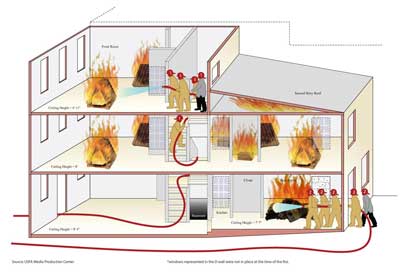 |
|
Figure 3. Engine 1 crew on third floor. Engine 2 suppressing fire in rear room on first floor |
Engine 2 and Truck 2 were operating at the rear of the structure. Truck 2 made forcible entry into the rear door on the first floor and opened the window adjacent to the door. When they entered, the door frame was on fire with smoke and flames rolling out overhead. There was extensive fire in the rear room on the first floor. Note: Just after the fires were ignited, Engine 2 realized they didn’t have enough hose to reach the rear of the structure. They added three more 50-foot sections of hose which, along with the unknown fire on the first floor, delayed their entry.
At this time, approximately 1143 hours or eight minutes after the fires had been ignited, Truck 2 positioned an extension ladder to the C-side window on the second floor and vented it. Fire immediately blew from the window. Engine 2 had to operate an estimated five to seven minutes extinguishing the fire on the first floor before they could proceed to the second floor for extinguishment. Truck 3 began operating a saw to open a ventilation hole in the roof above the front room of the third floor.
Conditions on the stairwells between the second and third floors deteriorated due to the fire drawing air and venting up the stairwell which was acting like a chimney for the heat and flames from the fires on the first and second floors. Heat and flames from the rear area of the second floor were also extending directly into the stairwell area. This was likely due to the ceiling having been pulled down in the bedroom during previous training exercises, and the fire entering the attic area under the second floor roof (Figure 3). The heat and flames exited this area through the voids in the wall on the stairwell and just below the window on the third floor landing (Photo 6).
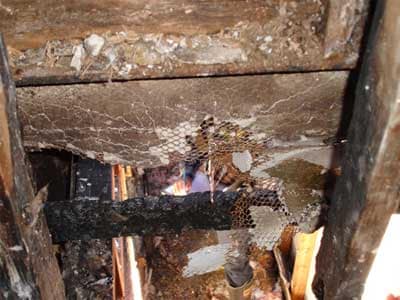 |
|
Photo 6. Void in wall just below window on third floor landing.
|
The E1 back-up fire fighter attempted to seek shelter up the stairs behind the victim and the instructor. The instructor called for more line and the back-up fire fighter had to reach through the flames to attempt to pull the hose around the corner of the stairs. The intense smoke and fire venting up the stairwell from the second floor was banking down to within a couple of feet of the stairs, greatly reducing visibility. The back-up fire fighter was forced up the stairs and was beginning to receive burns to her legs and her turn-out coat was on fire.
The Engine 1 adjunct instructor felt a rush of intense heat and knew something was wrong. He did not have a radio to make contact with the officer in charge, nor did he know of any alternative means of exit because they had not completed a walk-through or any pre-burn briefing prior to the training evolution. He leaned out of the window on the third floor landing to assess his situation and possibly make contact with someone. The back-up fire fighter came up the stairs and stated that she needed to exit because the conditions on the stairs were too intense. The adjunct instructor exited through the window onto the second floor roof and assisted the back-up fire fighter out of the window (Figure 4).
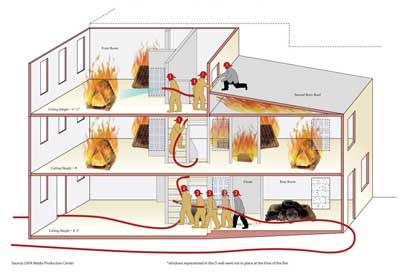 |
|
Figure 4. Engine 1 personnel operating on third floor and stairwell. Engine 2 advancing to the second floor. Engine 1 Adjunct Instructor on roof, remainder of crew inside
(Courtesy of USFA Media Production Center). |
The victim also attempted to exit through the window, but was severely impeded due to the height of the window sill and possible obstructions (Photo 7).
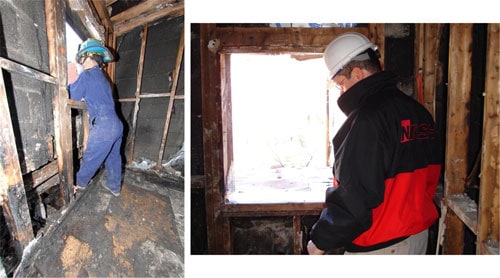 |
|
Photo 7. ATF investigator on the left is approximately the same height as the victim. NIOSH investigator on the right is approximately the same height as the Engine 1 adjunct instructor.
|
The two other recruits on Engine 1 were now on the landing between the second and third floors. The hose line was not advancing and they felt a rush of air go over them followed by heavy fire. They made their way to the bend of the stairs and saw the victim, who was alone, attempting to exit through the window. The victim was attempting to climb out of the window and screamed for them to retreat as the intense flames were venting out of the same window around her. The two recruits went back down the stairs and were faced with extensive fire. Note: The recruits stated that they didn’t know what to think about the victim being stuck in the window. They didn’t know if it was part of the training, and they didn’t have anyway nor anyone to ask. They decided it would be best to fight fire instead of just leaving the building. They pulled the nozzle down from the third floor and started to fight the fire on the second floor where they met Engine 2 (Figure 5).
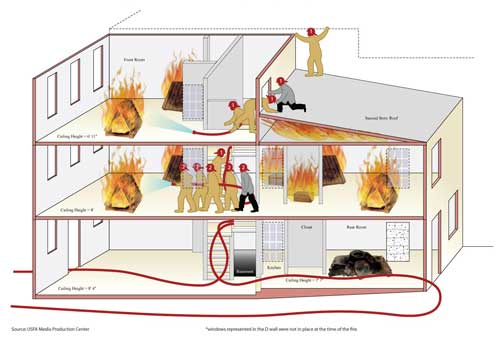 |
|
Figure 5. Engine 1 crew attempting to exit on to roof. Engine 2 crew suppressing fire in front room on second floor
(Courtesy of USFA Media Production Center). |
The two recruits from Engine 1 fought fire in the second floor closet area towards the rear of the structure. The Engine 2 crew continued to fight fire in the front of the second floor for another couple of minutes when the Engine 2 adjunct instructor heard screaming from the third floor.
The adjunct instructor from Engine 1 had immediately returned to the window after helping the second fire fighter on the line exit. The victim was at the window screaming for him to get her out of there. He reached in and grabbed her by her SCBA harness. He got her upper body out of the window, but could not pull her lower body through. He was pleading with her to help, but she said she couldn’t. He began yelling for help to anyone who could hear. He lost his grip and she slipped back inside the window. He reached back in to get her and her mask and helmet were off to one side exposing her face. Note: It is uncertain why the victim’s mask became partially dislodged. It was reported that the victim had several incidents during her training at the academy where she had experienced mask claustrophobia and would panic and remove her mask prematurely. However, she could have removed it in an attempt to articulate to the other recruits to retreat. Or, it could have also become dislodged from being caught on the window sill or a nail protruding from the window sill (Photo 8).
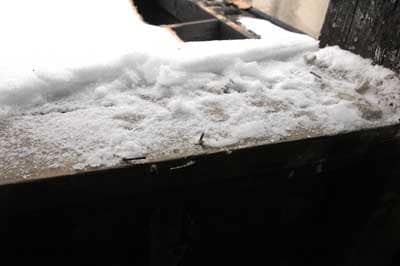 |
|
Photo 8. Nails that were exposed at the window sill on the third floor landing.
|
The victim’s mask was now free flowing air. She was screaming for help to get out of the building while attempting to exit through the window. The Engine 1 adjunct instructor was yelling for help to the crew he could now see at the roof’s edge above him. She again slipped back inside the window. This time the Engine 1 adjunct instructor was assisted by a member of Truck 3. The victim was lifeless and they had difficulty lifting her through the window. Two other members from Truck 3 came to assist.
The adjunct instructor from Engine 2 had run up the stairs after hearing someone screaming. He could see the victim’s body partially out of the window. As he got closer, he could see the adjunct instructor from Engine 1 attempting to pull the victim out of the window. The victim’s head and shoulders were out of the window. The adjunct instructor from Engine 2 reached down and lifted her legs up to a horizontal position and she immediately was pulled out of the window. The adjunct instructor from Engine 2 went back down the stairs to get the crew from Engine 2 and knocked down the extensive fire on the third floor (Figure 6). Members from Truck 3 on the second floor roof initiated life saving support. She was quickly removed from the roof and transported to a shock trauma center where she was pronounced dead.
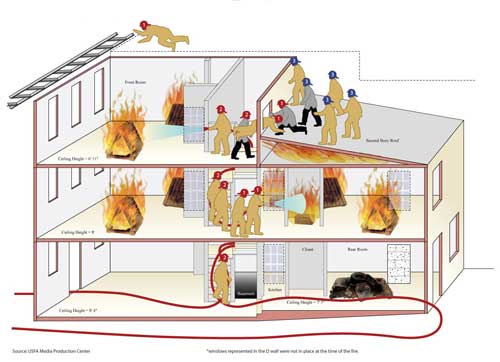 |
|
Figure 6. Engine 1 crew exiting to roof and down ladder. Engine 2 crew suppressing fire in front room of third floor. Truck 3 members assisting Engine 1 crew exiting window
(Courtesy of USFA Media Production Center). |
CAUSE OF DEATH
The autopsy report listed the victim’s cause of death as thermal injuries and asphyxia.
INJURIES
The Engine 1 adjunct instructor received first and second degree burns to the back of his neck, ears and wrists. He also received third degree burns to his fingers.
The Engine 1 back-up fire fighter received second degree burns to her calves. She also received first degree burns to her right arm from her shoulder to her elbow.
RECOMMENDATIONS
Recommendation #1: Fire departments should conduct live-fire training exercises in accordance with the most recent edition of NFPA 1403, Standard on Live-Fire Training Evolutions.
Discussion: Fire department policy and Maryland State law require compliance with NFPA 1403, Standard for Live Fire Training Evolutions. It is imperative that fire departments develop or follow the programs they have in place to ensure compliance with NFPA 1403.1 In this incident, specific examples of non-compliance with NFPA 1403 include, but are not limited to: lack of an incident command system; lack of a personnel accountability system; lack of an incident safety officer; inadequate preparation of the structure for live-fire training; insufficient water supply; the absence of a method of fire ground communication among the officer-in-charge and fire fighters; holes in walls, ceilings, and floors that were not patched; the number of training fires set; the locations of the training fires; instructors that did not have the recommended qualifications; an absence of pre-burn briefings and a walk-through, and extensive fuel loads.
Recommendation #2: Fire departments should ensure all training and education, including live fire training, is conducted under the direct supervision of a qualified instructor(s) who meets the requirements of NFPA 1041, Standard for Fire Service Instructor Professional Qualifications.
When conducting live fire training evolutions, NFPA 1403, Standard for Live Fire Training Evolutions,1 clearly outlines the requirements for instructors. There should be a lead instructor (officer-in-charge) that is ultimately responsible for conducting the live fire training and ensuring compliance with NFPA 1403. The lead instructor, all adjunct instructors, and the safety officer should meet the requirements of NFPA 1041, Standard for Fire Service Instructor Professional Qualifications.2 This ensures that these personnel have the necessary knowledge, skills, and abilities to ensure that the live fire training exercise will be a learning experience that also provides for the safety of all members. The intent of live fire training is to evaluate recruits to ensure they can operate during fire fighting operations and to meet the requirements of NFPA 1001, Standard for Fire Fighter Professional Qualifications, Fire Fighter Level I and II.3 When conducting live fire training for recruits in acquired structures, this event becomes a low frequency/high risk event in terms of risk management. To ensure for a safe outcome, the personnel assigned to manage this training must be properly trained and certified to provide the instruction. Fire departments should encourage and provide the means for members to continue their education and training for possible promotions to positions of increased responsibility.4 NFPA 1041 offers guidelines for instructors to supervise students and other instructors to ensure that applicable safety standards and policies are followed and directs them to NFPA 1403 to ensure the responsibilities of that national consensus standard are met.
Recommendation #3: Fire departments should provide the Training Academy and Safety Division with adequate resources, personnel, and equipment to accomplish their training mission safely.
Several problems identified during the NIOSH investigation were related to inadequate resources devoted to the Division of Training. This included the condemned burn building at the academy, the shortage of State-certified Instructors, inadequate staffing, inadequate/outdated PPE, faulty apparatus, and a shortage of radios. The hazards associated with fire fighting do not change between training and actual fire fighting operations. A safety officer, who meets the requirements of NFPA 1521, Standard for Fire Department Safety Officer, 5 should oversee all operations at training academies for adherence to safety guidelines set forth by the fire department and national consensus standards.
Recommendation #4: Fire departments should screen recruits to ensure they meet the physical performance requirements as established by the fire department prior to entering a training program to become a fire fighter.
Fire departments should develop criteria, such as the Candidate Physical Ability Test Program (CPAT) as described in the Fire Service Joint Labor Management Wellness/Fitness Initiative,6 to ensure that recruits are physically able to safely and effectively complete the critical tasks associated with fire fighting, such as the candidate’s ability to operate with sense deprivation such as obscured visibility. The department involved in this incident did not have any physical fitness requirements. Recruits participated in physical fitness training, but there weren’t any minimum performance requirements.
Recommendation #5: Fire departments should develop and maintain a comprehensive respiratory protection program which complies with NFPA 1404, Standard for Fire Service Respiratory Protection Training.
Fire fighting is an extremely physically and psychologically demanding occupation that requires strength, physical agility and endurance as well as the ability to operate effectively with the limitations from self contained breathing apparatus (SCBA) and other personal protective equipment. The fact that a fire fighter may have the physical ability to perform functions such as hose advancement or rescuing victims with their vision un-obscured, does not mean that the fire fighter can perform any of those functions while using required personal protective equipment such as SCBA. Fire departments should recognize and implement SCBA best practices such as described by the minimum requirements outlined in NFPA 1404, Standard for Fire Service Respiratory Protection Training. 7
Fire fighter applicants should be screened for the ability to operate with sensory deprivation, such as phobias regarding sight-obscuration and covered-face issues. Recruit fire fighters that cannot successfully pass the SCBA portion of recruit school due to medical or psychological issues that cause them to panic or not perform should not be allowed to progress further in the recruit training process until they can overcome their inability to reliably use the SCBA. Fire department physicians or other trained medical providers can assess these conditions, recommend treatment, and if warranted, recommend release by the fire department.
Developing a respiratory protection program that includes a minimum level of fitness, health and wellness, and medical screening such as NFPA 1582, Standard on Comprehensive Occupational Medical Program for Fire Departments,8 should be an integral part of a fire department’s health and wellness plan for recruits and the entire department. Incumbent fire fighters should participate in annual medical physicals and surveillance as well as fitness assessments as outlined in the (IAFF)/International Association of Fire Chiefs (IAFC) Fire Service Joint Labor Management Wellness/Fitness Initiative.6
Recommendation #6: Fire departments should ensure all recruits meet the requirements of NFPA 1582, Standard on Comprehensive Occupational Medical Program for Fire Departments prior to entering the training program.
Recommended requirements for medical evaluations and fitness for duty for structural fire fighting can be found in NFPA 1582, Standard on Comprehensive Occupational Medical Program for Fire Departments 8 and in the International Association of Fire Fighters (IAFF)/International Association of Fire Chiefs (IAFC) Fire Service Joint Labor Management Wellness/Fitness Initiative.6 According to these recommended requirements, the fire department should have an officially-designated physician who is responsible for guiding, directing, and advising fire department members with regard to their health, fitness, and suitability for duty as required by NFPA 1500, Standard on Fire Department Occupational Safety and Health Program.9 Fire departments should develop criteria, such as the Candidate Physical Ability Test Program (CPAT) as described in the Fire Service Joint Labor Management Wellness/Fitness Initiative,6 to ensure that recruits are physically able to safely and effectively complete the critical tasks associated with fire fighting. The department involved in this incident did not have any physical fitness requirements. Recruits participated in physical training, but there weren’t any minimum performance requirements.
It is critical that fire departments are able to diagnose mask phobia and provide treatment prior to a recruit becoming a fire fighter or before an existing fire fighter wears a mask again in an immediately dangerous to life or health (IDLH) atmosphere. Feelings of claustrophobia are not unusual when wearing a protective mask. That feeling can be exaggerated by the physical stressors and environmental conditions that fire fighters routinely face. The mental aspects of wearing SCBA must be addressed through the fire department physician. A complete medical examination may not initially identify issues with wearing respiratory protection. If an issue surfaces during the recruit training program, the fire department should work closely with the fire department physician or other qualified medical provider to attempt to overcome this phobia.
Prior to this incident, it was documented and reported to the NIOSH investigators that the victim had numerous episodes of mask phobia that resulted in her removing her facepiece during training. The fire department involved in this incident used a combination of graded exposure and flooding techniques.a They increased the recruit’s exposures and duration wearing the mask while being exposed in live-fire conditions (IDLH). Fire departments should ensure that a recruit or fire fighter who experiences mask phobia is not placed in an IDLH atmosphere until they are able to overcome their phobia.
a In a graded exposure, the recruit or fire fighter could wear the mask in increasing increments in a safe environment. Flooding is where the recruit or fire fighter is exposed to their phobia at full intensity, such as in an IDLH atmosphere, for an extended amount of time.
Recommendation #7: Fire departments should develop an inspection criteria to ensure that all protective ensembles meet the requirements of NFPA 1851, Standard on Selection, Care, and Maintenance of Structural Fire Fighting Protective Ensembles.
NFPA 1851, Standard on the Selection, Care, and Maintenance of Protective Ensembles for Structural Fire Fighting provides specific requirements for the retirement of gear.10 Fire departments should develop specific criteria consistent with manufacturer’s recommendations for the removal of protective gear and clothing from service. Conditions that should be considered to retire protective gear or clothing include, but are not limited to:
- Physical damage from use or improper cleaning
- Economical feasibility for repair. If >50% of replacement cost, then replace.
- Ability to remove hazards or provide thermal protection.
Protective ensembles that are retired should be disposed of or destroyed to ensure that they cannot be used in any emergency operations, fire fighting, and training.10
The latest edition of NFPA 1851, August 2007, recommends mandatory retirement for all structural fire fighting protective gear at 10 years from the date of manufacture regardless of the level of use. The fire department sent their old turnout gear that was removed from service to the training academy for use by recruits.
Recommendation #8: Fire departments should ensure coordinated communication between the Instructor-in-charge and the live-fire training participants.
Proper communication is critical to the safety of fire fighters at any incident site, including training. Portable radios should be used to keep all personnel on the scene in communication with the Instructor-in-charge (IC). 9 The fire department issues portable radios to all fire fighters in the field. Portable radios should also be issued to all recruits and instructors in training exercises. The radios should be designed and positioned to allow the fire fighter to monitor and transmit a clear message. These radios should be well maintained and inspected by qualified personnel on a regular basis. All of the recruits, and at least two instructors, did not have a portable radio during this live fire training because there reportedly weren’t enough available.
Recommendation #9: Fire departments should utilize the incident command system and a personnel accountability system, for all incidents, including live fire training exercises, that meets the requirements of NFPA 1561, Standard on Emergency Services Incident Management System.
The personnel accountability system is a method of maintaining constant awareness of the identities and location of all personnel involved in emergency operations. The personnel accountability system philosophy starts with the incident command system principles of company/crew unity and unity of command. These duties can be fulfilled initially maintaining company accountability by documenting the situation status and resource status on the tactical worksheet. Other methods include command boards, apparatus riding lists, company personnel boards, and electronic bar-coding systems. These components can be used in conjunction with one another to facilitate the tracking of personnel by both location and function. The components of the personnel accountability system should be modular and expand with the size and complexity of the incident. The function of personnel accountability should be assigned to an accountability officer (resource status and situation status) who is responsible for maintaining the status of all assigned resources at an incident. 11
Training should be designed to reinforce the use of safe practices for situations that fire fighters may encounter on the fireground. Company/crew continuity relies on the following factors that are instrumental in developing safe fire fighters: knowing who is in your company/crew and the officer or crew leader, staying within visual contact at all times (if visibility is obscured then crews should remain within touch or voice distance of each other), communicating your needs and observations to the officer/crew leader, rotating to rehab and staging as a crew, and watching your company/crew members (practice a strong “buddy-care” approach).12 These key factors help to reduce serious injury or even death resulting from the risks involved in fire fighting operations and help to discourage freelancing. Companies/crews that enter a hazardous environment together must leave together.
Recommendation #10: Fire departments should create a training atmosphere that is free from intimidation and conducive to learning.
The purpose of training is to teach fire fighters in a safe environment that supports learning proper techniques to accomplish an assignment. Training exercises should not be used to pressure recruits to drop out.13 By fostering a positive learning environment, fire departments can capitalize on each individual’s analytical skills to become problem solvers within a team organization.
Recommendation #11: States should develop a permitting procedure for live-fire training to be conducted at acquired structures and also ensure that all the requirements of NFPA 1403 have been met before issuing the permit.
Discussion: NFPA 1403, Standard on Live Fire Training Evolutions,1 is the standard for conducting live-fire training evolutions at approved training centers, and as in this case, acquired structures. Approved training centers have burn buildings that are specifically designed for repeated live-fire training evolutions. The structures that are acquired for live-fire training are usually in disrepair and were never designed for live-fire training. Any building that is acquired for live-fire training must go through an inspection process to identify and eliminate any hazards, or potential hazards that may be present to the participants, the public, and the environment. An application for permit procedure that is overseen by the state through local officials or a State representative would help ensure safety. If training facilities with approved burn buildings are available, then live-fire training exercises should not be conducted in acquired structures.1 As mentioned, the department had a burn building on the grounds of the training academy but it was condemned. The department also had a mobile live-fire training simulator at the academy, but it was not being used due to the limitations of its size and safety features which reduced the number of recruits the fire department could train in each evolution.
REFERENCES
- NFPA [2007]. NFPA 1403, Standard on live fire training evolutions. Quincy, MA: National Fire Protection Association.
- NFPA [2007]. NFPA 1041, Standard for fire service instructor qualifications. Quincy, MA: National Fire Protection Association.
- NFPA [2008]. NFPA 1001: Standard for fire fighter professional qualifications. Quincy, MA: National Fire Protection Association.
- Clinton H. Smoke [2005].Company Officer, 2nd Edition. New York: Delmar Publishers.
- NFPA [2008]. NFPA 1521: Standard for fire department safety officer. Quincy, MA: National Fire Protection Association.
- IAFF, IAFC [2000]. The fire service joint labor management wellness/fitness initiative. Washington, DC: International Association of Fire Fighters, International Association of Fire Chiefs.
- NFPA [2006]. NFPA 1404: Standard for fire service respiratory protection training. Quincy, MA: National Fire Protection Association.
- NFPA [2007]. NFPA 1582: Standard on comprehensive occupational medical program for fire departments. Quincy, MA: National Fire Protection Association.
- NFPA [2007]. NFPA 1500: Standard on fire department occupational safety and health program. Quincy, MA: National Fire Protection Association.
- NFPA [2008]. NFPA 1851, Standard on selection, care, and maintenance of protective ensembles for structural fire fighting. Quincy, MA: National Fire Protection Association..
- NFPA [2008]. NFPA 1561: Standard on emergency services incident management system. Quincy, MA: National Fire Protection Association.
- International Fire Service Training Association [1995]. Essentials of fire fighting. 4th ed. Stillwater, OK: Oklahoma State University, Fire Protection Publications.
- WFS [1999]. Fixing Fire Training.external icon [https://i-women.org/publication/view/fixing-fire-training/] (Link updated 05/13/2015)
INVESTIGATOR INFORMATION
This incident was investigated by Jay Tarley and Steve Berardinelli, Safety and Occupational Health Specialists, and Timothy Merinar, Safety Engineer, Surveillance and Field Investigations Branch, Division of Safety Research, NIOSH. The report was written by Jay Tarley. Expert and technical reviews were provided by Dr. David Dejoy, Professor, College of Public Health, University of Georgia, and Murrey Loflin, Director of Fire Training, West Virginia University, and NFPA 1500 Task Group Chairman. Technical review for Appendix I was Mr. Loflin assisted with writing the accountability recommendation. Dan Madrzykowski from NIST provided the information in Appendix I.
Appendix
NIST has conducted heat release rate experiments on “A frame” or “tepee” pallet arrangements as shown in Figure 2 and Photo 9.b Excelsior was used as the initial fuel to ignite the pallets. The excelsior used was in bales that were approximately 18 by 14 by 36 inches. Each bale of excelsior weighed approximately 60 lbs. A half bale was used with each set of three pallets. The baled excelsior was pulled apart to fill the interior space formed by the three pallets.
A variety of pallets were used since there is no”standard” pallet that is identified or used in fire fighter training. The total weights for three pallets ranged from 90 to 150 lbs in the NIST experiments. The resulting peak heat release rates ranged from 1,500 kW to 3,000 kW (Photo 9).
b Madrzykowski D [2008]. Fire Dynamics for the Fire Service. Presented to the NFPA Technical Committee on Fire Service Training, Las Vegas, NV, May 30, 2008.
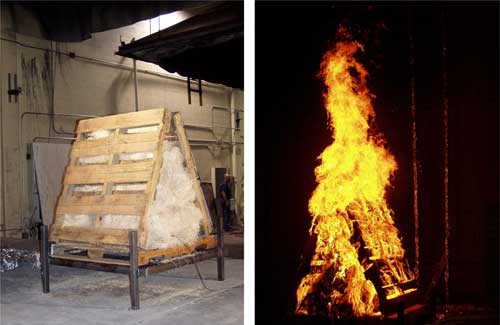 |
|
Photo 9. NIST heat release experiment.
|
In this incident, the three lean-to fires could be considered as equaling one “A-frame” fire in the NIST experiment. Taking into account all of the staged training fires in this incident, the training fires equaled approximately four “A-frame” fires, suggesting a heat release rate of approximately 8,000kW. With the addition of the fire load in the rear room on the first floor, the exposed wood framing members, the insulation, and added bales of excelsior, it can be estimated that the total heat release rate for the structure was in excess of 10,000 kW. It is unknown whether a flashover occurred at this training exercise. Based on the ventilation limits of a residential room with a single open doorway, the minimum amount of energy needed to flashover a room is approximately 2,000 kW.c
c Madrzykowski, D [2007]. Fatal Training Fires: Fire Analysis for the Fire Service. Interflam Conference, 11th Proceedings. Sept 3-5, 2007, London, England, 1169-1180 pp.
This page was last updated on 12/08/08.
